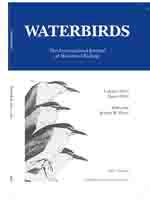The diet of the Neotropical Cormorant (Phalacrocorax brasilianus) was evaluated in the Limay River basin, a freshwater system invaded by exotic salmonids. Analyses of 106 pellets showed that fish were the most important prey (79.9% by numerical frequency and 86.2% by frequency of occurrence), followed by two crustacean species. Among fish, the most common species were exotic salmonids, representing 84% by numerical frequency. Morphometric comparisons enabled differentiation of sagitta otoliths from Oncorhynchus mykiss and Salmo trutta and permitted determination of similar contributions of these species to the diet. Although a wide prey-size range was found, 85% of fish were smaller than 150 mm in length. The results suggest that the Neotropical Cormorant has adapted to changes in the fish community after the introduction of salmonids. Flexible feeding strategies of the Neotropical Cormorant and/or its capacity to exploit different environments probably make it less vulnerable to environmental changes produced by introduction of exotic fish.
How to translate text using browser tools
1 March 2012
Diet of the Neotropical Cormorant (Phalacrocorax brasilianus) in a Patagonian Freshwater Environment Invaded by Exotic Fish
Pablo A. E. Alarcón,
Patricio J. Macchi,
Ana Trejo,
Marcelo F. Alonso
ACCESS THE FULL ARTICLE

Waterbirds
Vol. 35 • No. 1
March 2012
Vol. 35 • No. 1
March 2012
exotic fish
feeding plasticity
Patagonian environments
Phalacrocorax brasilianus




